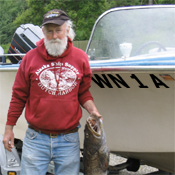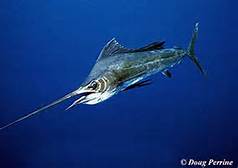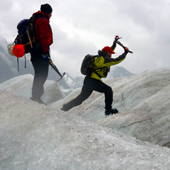#892514 - 04/20/14 05:56 PM
 Re: Puget Sound Wild Hatchery Mess
[Re: Carcassman]
Re: Puget Sound Wild Hatchery Mess
[Re: Carcassman]
|

Spawner

Registered: 09/17/04
Posts: 594
Loc: Seattle
|
One of the problems in the ocean is that steelhead apparently eat a lot of plastic, which ends up killing them. Fits what Smalma said, the longer they are out there eating plastics.
We could, of course, clean up our act and not dispose of plastics as we do. nah, that's a non-starter. The plastic ocean, it is a problem and steelhead are at risk because they basically feed in the top of the water column where the most plastics is found. It probably kills some of them, nobody is out in the ocean looking for dead steelhead. The bigger problem is exposure to pollutants and the resulting loss of reproductive potential. Plastic particles concentrate all of the persistent organic pollutants on their surface by a factor of 1 to 10 million times over the sea water concentrations. The other part of the story is that as the larger pieces of plastic break up the total volume remains constant but the surface area is always increasing. Styrofoam coolers are one of the worst offenders. Small particles of styrofoam are common in ocean caught steelhead stomachs along with large pieces of other plastics and wads of mono filament line. There have been a few studies addressing the absorption of pollutants from plastics in fish digestive systems. I don't think anyone has measured the actual pollutant concentration in adult steelhead. I suspect it is similar to that of chinnok salmon if not higher. The link is to an extended abstract discussing the problem. Plastic in Steelhead
|
|
Top
|
|
|
|
#892515 - 04/20/14 06:18 PM
 Re: Puget Sound Wild Hatchery Mess
[Re: WN1A]
Re: Puget Sound Wild Hatchery Mess
[Re: WN1A]
|

River Nutrients
Registered: 11/21/07
Posts: 7428
Loc: Olema,California,Planet Earth
|
The couple of long-term data sets I have seen on steelhead age show a couple of interesting things. The R/S increases as total age of the fish (measured only for first-returning fish) decreases. This fits with the observation that the longer they spend in the ocean, the fewer come back.
Age in steelhead is interesting. It appears that freshwater age is primarily controlled by the environment; higher productivity in the stream produces younger smolts. It also, based on Canadian studies, produces more smolts. This makes a two-edged sword that lowers returns; low FW productivity produces fewer and older smolts.
At the same time, salt-water age appears to be primarily controlled by inheritance. This is why practices like breeding the big Skamania summers with each other led to big fish coming back but fewer fish. As I recall, removing the smaller, younger fish from the broodstock led to a program that wasn't self sustaining. Again, older fish, lower R/S.
The above is applied to first returning fish only.
|
|
Top
|
|
|
|
#892688 - 04/22/14 01:05 PM
 Re: Puget Sound Wild Hatchery Mess
[Re: Carcassman]
Re: Puget Sound Wild Hatchery Mess
[Re: Carcassman]
|

Spawner

Registered: 12/05/02
Posts: 527
|
Wn1A, thanks for the link on plastics in steelhead. I think that is a very interesting subject to be aware of. Can you possibly provide some more links to research articles on this topic?
thanks in advance.
_________________________
FishDoctor
|
|
Top
|
|
|
|
#892698 - 04/22/14 04:58 PM
 Re: Puget Sound Wild Hatchery Mess
[Re: FishDoctor]
Re: Puget Sound Wild Hatchery Mess
[Re: FishDoctor]
|

Spawner

Registered: 09/17/04
Posts: 594
Loc: Seattle
|
Wn1A, thanks for the link on plastics in steelhead. I think that is a very interesting subject to be aware of. Can you possibly provide some more links to research articles on this topic?
thanks in advance.
As far as I know this is the only research article that addresses plastic ingestion by salmon and steelhead in salt water. The data for this report was collected while examining stomach contents of ocean sampled fish for feeding and bioenergetics studies. I have been told that smolts that are collected in yearly coastal surveys often have plastic in their stomachs but it is not reported. Plastic ingestion has been observed in other species of marine food fish. Big Fish Eat Plastic One question that only recently has been addressed; are the pollutants concentrated on and in the plastic absorbed by fish when the plastic is ingested. The answer seems to be yes from the link below. Plastic Ingestion Studies that look at pollutants in fish are mos often addressing the danger of eating contaminated fish and not how the fish are harmed. There is a growing concern though of the impacts on reproductive success of fish exposed to pollutants. The link below is to a local example. Puget Sound
|
|
Top
|
|
|
|
#892708 - 04/22/14 09:22 PM
 Re: Puget Sound Wild Hatchery Mess
[Re: WN1A]
Re: Puget Sound Wild Hatchery Mess
[Re: WN1A]
|

Spawner

Registered: 03/07/12
Posts: 806
|
I wonder what the proportion of Pinks, Silvers, Nooks, Reds, Chums, and hatchery Steelhead was back in 1890 vs. today.
_________________________
Why build in the flood plain?
|
|
Top
|
|
|
|
#892711 - 04/22/14 09:48 PM
 Re: Puget Sound Wild Hatchery Mess
[Re: Salman]
Re: Puget Sound Wild Hatchery Mess
[Re: Salman]
|

River Nutrients
Registered: 11/21/07
Posts: 7428
Loc: Olema,California,Planet Earth
|
5-10% of the wild, if we're lucky, at least in the lower 48, from 1800. By 1890 we had already hammered a number of major populations (Columbia, Sacramento, for example)
|
|
Top
|
|
|
|
#892730 - 04/23/14 04:57 AM
 Re: Puget Sound Wild Hatchery Mess
[Re: Moravec]
Re: Puget Sound Wild Hatchery Mess
[Re: Moravec]
|

Repeat Spawner
Registered: 03/05/00
Posts: 1092
|
Plastic!?!?!? great.....another problem to add to the list. What's next? Radioactive flotsam and jetsam?
|
|
Top
|
|
|
|
#892764 - 04/23/14 02:58 PM
 Re: Puget Sound Wild Hatchery Mess
[Re: ]
Re: Puget Sound Wild Hatchery Mess
[Re: ]
|

Repeat Spawner
Registered: 10/20/10
Posts: 1279
Loc: Seattle
|
I am not elite but I prefer wild. I grew up a ham and egger,fishing in chuck Taylor's and cut offs for summer runs , two pairs of pants and as many shirts as you could wear for winter fish and you came home soaked every trip. If I could only fly fish for steelhead the rest of my life knowing my great grand kids could maybe see a wild one I am all in vs a river full of 5 lb clones.
_________________________
Once you go black you never go back
|
|
Top
|
|
|
|
#892842 - 04/23/14 10:33 PM
 Re: Puget Sound Wild Hatchery Mess
[Re: Backtrollin]
Re: Puget Sound Wild Hatchery Mess
[Re: Backtrollin]
|

Carcass

Registered: 01/09/14
Posts: 2312
Loc: Sky River(WA) Clearwater(Id)
|
With out local hatchery Steelhead the passionate fishermen may be a dying breed. Steelhead fishing will be for the elite,it will be for the people that can afford to travel great distances and pay for hotels.
+1 The term "elite" does get tossed around loosely here. Local fisheries are very important for steelhead fisherman and new recruits. We cant all afford to travel Out of state every few weeks to cure our addiction. Most of us started out a few miles from home on a local stream with less than 100$ of gear to our disposal. Im assuming the word "elite" is describing the dude with a good car, tank of gas, time, and a 2k spey rod 
_________________________
|
|
Top
|
|
|
|
#892849 - 04/23/14 11:01 PM
 Re: Puget Sound Wild Hatchery Mess
[Re: ]
Re: Puget Sound Wild Hatchery Mess
[Re: ]
|


Registered: 03/27/08
Posts: 1045
Loc: Snoqualmie WA/Cordova AK
|
I'm not missing any point, for someone, somewhere, all fishing is local , just not maybe for me, or you. If all local fisheries were good, then the runs would be good....and things would be fine and dandy. Mouth of the Tolt is still open more than not, so fishing is available...its the catching part that's changed.
Expecting things not to change, given the growth of the Puget sound basin, seems foolish to me.
Another thing that seems foolish is tagging someone as elite...as long as there's been fishing, there has been someone who has an issue with anothers, catch, time, or tactics when it comes to his fishing.
While we are talking about missing points....the term elite is rendered meaningless when it gets used and abused like it does on this board, and certainly doesn't help the sportfishing community as a whole.
Get the point yet ?
We all as sportsmen can agree that if we kill off sportfishing opportunity in Puget Sound (and the writing is on the wall, if you can't catch fish that is called NO OPPORTUNITY), then only those with the means to pay to fish the remaining world-class fisheries will see great steelhead fishing. If there is no fishing locally, mine will be the final generation of steelhead fishermen in Puget Sound.
|
|
Top
|
|
|
|
#892863 - 04/24/14 12:43 AM
 Re: Puget Sound Wild Hatchery Mess
[Re: Moravec]
Re: Puget Sound Wild Hatchery Mess
[Re: Moravec]
|

Spawner

Registered: 03/07/12
Posts: 806
|
How about blaming some of these backseat fisherman who live in different countries from where their CATCH comes from? You know the ones from Japan and China that send their lousy money our way so we can send them highly valued commodities theirs? They DO have an effect even if they aren't buying Steelhead directly. Backseat, clown, know nothing about something connoisseur's.
Edited by Salman (04/24/14 12:44 AM)
_________________________
Why build in the flood plain?
|
|
Top
|
|
|
|
#892875 - 04/24/14 01:50 AM
 Re: Puget Sound Wild Hatchery Mess
[Re: Salman]
Re: Puget Sound Wild Hatchery Mess
[Re: Salman]
|

Fry
Registered: 10/19/00
Posts: 31
Loc: Seattle, WA
|
To my fellow steelheaders: The recent decision to not plant hatchery smolts in Puget Sound rivers this spring is something we should all be celebrating. We have been planting these rivers for decades and watched both the wild runs and the hatchery runs dwindle. To continue doing the same thing and expecting a different outcome is, as they say, the very definition of insanity. Here are some reasons why this is our best shot at ANY kind of steelhead fishery in future years.
The hatcheries are not working. The run size, average fish size and quality of the angling experience are all trending downward. Why else would we call them "brats?" Of course, we adjust as our baseline expectations diminish, but from any kind of objective perspective, Puget Sound hatchery steelhead fisheries are at a low point. It's worth noting here that the actual Chambers Creek steelhead (from which our modern winter hatchery fish were created) has already gone extinct.
Cost: The hatcheries are also expensive, providing one of the lowest returns on investment of any public expenditure. A single hatchery steelhead harvested from the Nooksack River, has, in recent years, cost up to $2,400 to produce. On the Skagit, where it's a little better, the cost per harvested hatchery steelhead has been as high as $900. I can't imagine our non-fishing neighbors feeling very good about subsidizing a few people's recreation at this rate.
Science: Every major, peer-reviewed scientific study in the last decade has shown clearly that the presence of hatchery fish is a powerful detriment to wild fish recovery. When you ask WFC to spend money on "real science" or studies, I would argue the evidence is already there.
Habitat: According to recent surveys, the returns of wild fish are far below the carrying capacity of available spawning and rearing habitat in many Puget Sound rivers. While habitat has been damaged, it isn't the reason we have so few wild fish returning.
Elitism: The desire to recover wild steelhead isn't just an elitist, tree-hugging love of the beauty of wild fish. The fact is, they are our best shot at having any kind of fishery in the future. As hatchery returns trend toward zero, a healthy, sustainable (and free) run of wild steelhead provides recreational opportunities long into the future.
Proof: When Mt. St. Helens errupted, for all intents and purposes, it destroyed the Toutle River habitat with enormous flows of superheated ash and mud. The state abandoned its hatchery plants for this very reason. And yet, within seven years, there were more wild winter steelhead spawning in the Toutle than in any other lower Columbia tributary. As soon as DFW saw this and decided to "help" Mother Nature with renewed hatchery supplementation, the wild population crashed.
Proof: On the Salmon River in Oregon, the wild coho run had dwindled to a handful of returning spawners under decades of heavy hatchery supplementation. When the hatchery program was cancelled, the wild coho rebounded spectacularly (and immediately) coming back 3,500 strong within, I believe, less than four years.
Proof: Before the hatchery program on the Skagit ramped up to the massive plants we see today, the HARVEST of winter steelhead was frequently more than 20,000 fish per year. As the hatchery plants increased, instead of seeing more fish return, the downward spiral began. Today, the thought of harvesting 20,000 winter steelhead from the Skagit is beyond belief--that number represents far more than the total returns of hatchery and wild fish combined. Consider these numbers when you assess the quality of the fishery we have after decades of hatchery "supplementation."
Conclusion: Sure, we can continue to blame ocean conditions and plastic ingestion (neither of which we can do much about in the near term) or lack of freshwater habitat (not true) or pollution in the Sound, or commercial harvest, or tribal gillnets...but it's entirely possible, and even likely, that it's our hatcheries themselves that are causing the lack of fish.
Will we see the mind-blowing recoveries of wild fish like we've witnessed on the Toutle or the Salmon? That I cannot guarantee. But I do know that it's our best shot--and perhaps the only one we can actually control--for strong, healthy Puget Sound steelhead fisheries. Let's stop doing the same thing and expecting a different outcome. Celebrate the fact that we're on the brink of trying something new, something based on solid science, something that gives us a chance at quality fishing. This should be the best news any steelheader has heard in the last 30 years.
Skookum
|
|
Top
|
|
|
|
#892880 - 04/24/14 02:46 AM
 Re: Puget Sound Wild Hatchery Mess
[Re: Skookum]
Re: Puget Sound Wild Hatchery Mess
[Re: Skookum]
|

Smolt
Registered: 04/19/14
Posts: 81
Loc: washington
|
The wild fish are pretty expensive also. We are spending 150 million a year on habitat restoration just in Puget Sound. They are not spending that to recover hatchery fish. So how much is that per fish that we don't even fish for? The statewide cost estimates for steelhead and salmon habitat recovery is 5.5 billion dollars from 2010 to 2019.
And I have no issue with the money being spent. I would like them to spend more to restore the habitat. But it may not be enough.
The bottom line is only 20% or less of the smolts leaving Puget Sound make it out. We are losing 80% before they get to the ocean. It is being studied. Look up the Salish Sea Marine Survival Project. Read the reports and they also have video or two.
Nothing will save these steelhead unless we figure this out and ways to mitigate the losses. And it has nothing to do with hatchery fish. It is an in Puget Sound and the Salish Sea issue.
Edited by pijon (04/24/14 03:13 AM)
|
|
Top
|
|
|
|
#892887 - 04/24/14 09:24 AM
 Re: Puget Sound Wild Hatchery Mess
[Re: Skookum]
Re: Puget Sound Wild Hatchery Mess
[Re: Skookum]
|

Juvenile at Sea
Registered: 12/25/09
Posts: 141
Loc: SW WA.
|
Cost: The hatcheries are also expensive, providing one of the lowest returns on investment of any public expenditure. A single hatchery steelhead harvested from the Nooksack River, has, in recent years, cost up to $2,400 to produce. On the Skagit, where it's a little better, the cost per harvested hatchery steelhead has been as high as $900. I can't imagine our non-fishing neighbors feeling very good about subsidizing a few people's recreation at this rate.
Skookum
If it costs 1000$ a fish to raise at the hatchery and we then double capacity it cuts the cost per fish nearly in half. If we cut capacity by half it doubles the cost of each hatchery fish. Most hatcheries have been cutting production.
|
|
Top
|
|
|
|
#892888 - 04/24/14 09:33 AM
 Re: Puget Sound Wild Hatchery Mess
[Re: Skookum]
Re: Puget Sound Wild Hatchery Mess
[Re: Skookum]
|

Juvenile at Sea
Registered: 12/25/09
Posts: 141
Loc: SW WA.
|
The hatcheries are not working. The run size, average fish size and quality of the angling experience are all trending downward. Why else would we call them "brats?" Skookum
In the years prior to fin clipping hatcheries selected the best looking fish to spawn. This included native steelhead. Catching 12-17 lb hatchery steelhead was common. Fin clipping and the ESA limited the available broodstock and in several fish generations they started showing the results of inbreeding, retarded dwarfs, quite common in the genetics of ALL species of animals when they are inbred generation after generation.
Edited by billjr64 (04/24/14 09:39 AM)
|
|
Top
|
|
|
|
|
|
0 registered (),
319
Guests and
7
Spiders online. |
|
Key:
Admin,
Global Mod,
Mod
|
|
11498 Members
16 Forums
63778 Topics
645368 Posts
Max Online: 3001 @ 01/28/20 02:48 PM
|
|
|













 Previous Topic
Previous Topic Index
Index

